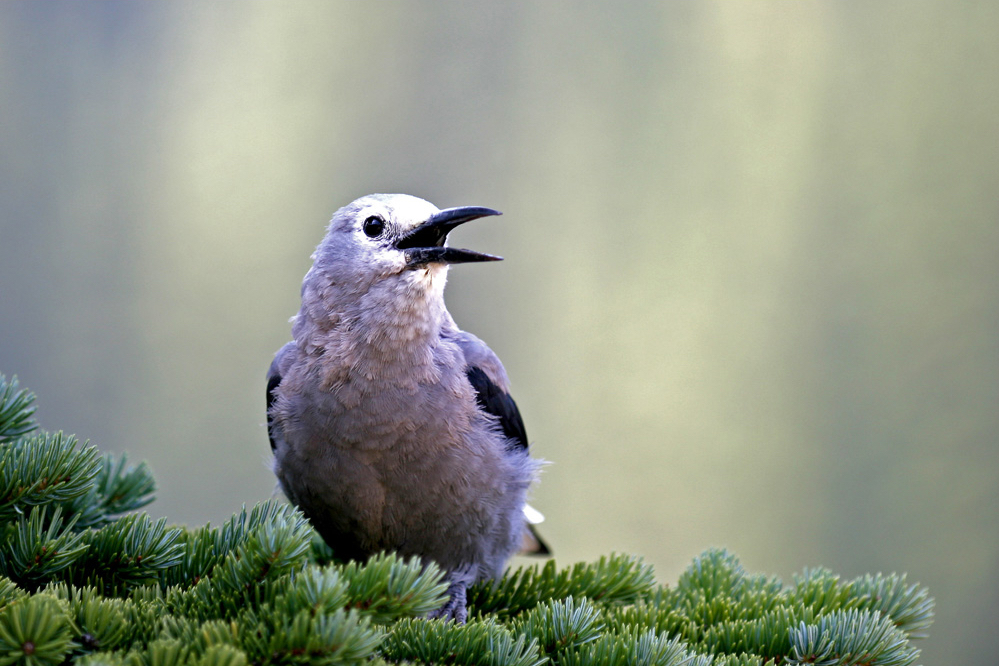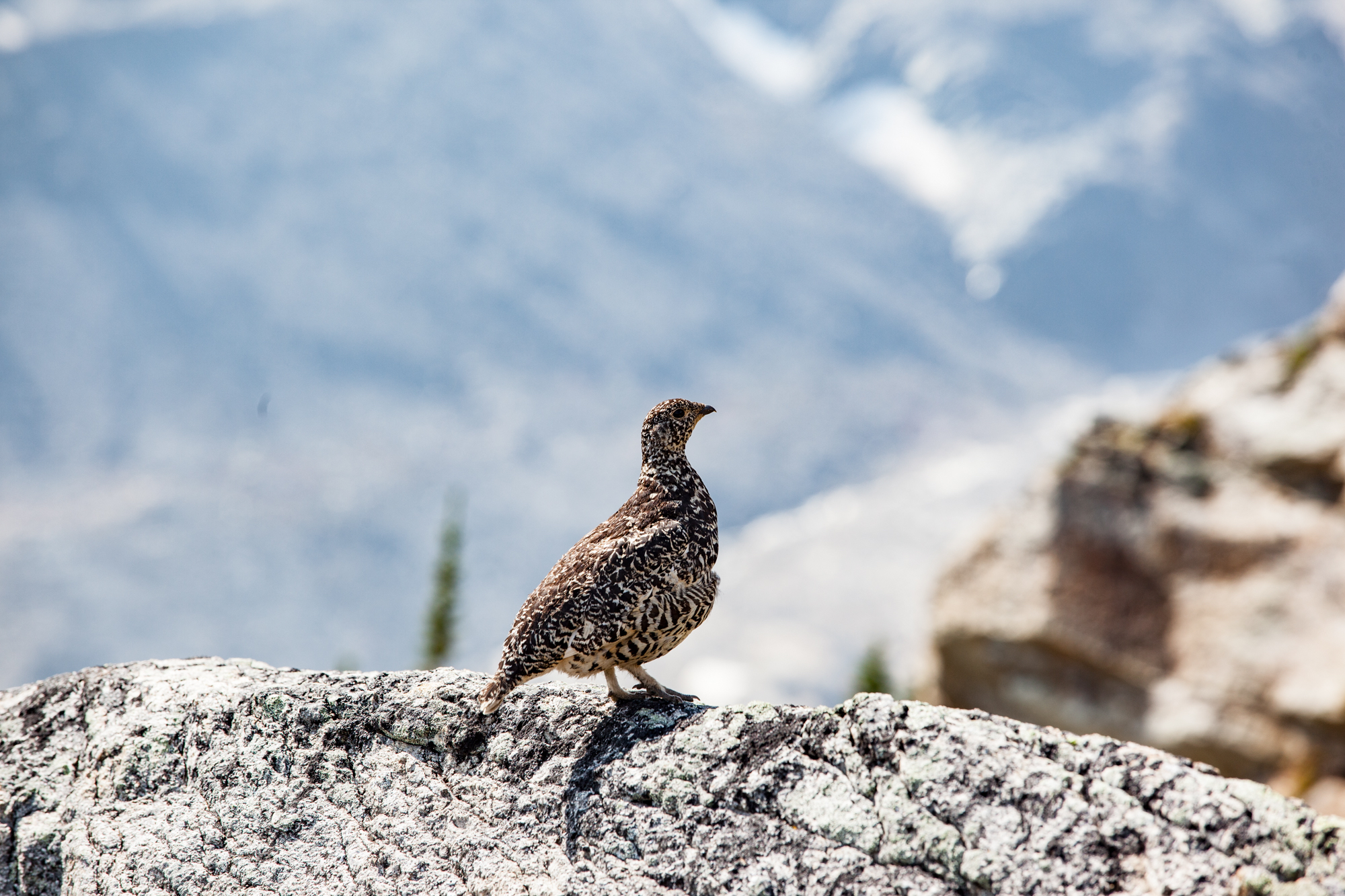Canada's mountain birds
Editor's note: About 60 species of birds in Canada are considered to be alpine specialists or elevation generalists. This article by Kathy Martin (Department of Forest and Conservation Sciences, University of British Columbia, Vancouver, and Environment and Climate Change Canada, Pacific Wildlife Research Centre, Delta, British Columbia) shares some of the challenges and opportunities that the mountains offer as a home base for some of the worlds hardiest and best-adapted bird species.
This article first appeared in the ACC's 2018 State of the Mountains Report. We'll continue to publish articles exploring the science of the current state of Canada's alpine on our blog throughout the year. Find them all here.
White-tailed ptarmigan in the Purcell Mountains, BC. Photo by Zoltan Kenwell.
Mountain habitat
Mountain habitats have been identified as important habitat year-round for many of Canada’s birds, but only five species, including White-tailed Ptarmigan and Gray-crowned Rosy-Finch, are considered to be alpine specialists, breeding exclusively in the high mountains. However, over 55 species are elevation generalists, occurring in both high and low elevations (e.g. Savannah Sparrow, Golden Plover). Knowledge of the population status of most birds breeding in Canada’s mountains is limited, but there is evidence that mountains provide birds with high quality habitats for breeding and migration, a role that becomes increasingly important given the more rapid loss of lower elevation habitats. For example, mountain habitats support stable populations for generalist species, such as Horned Lark, a species showing rapid declines at low elevations across North America.
Breeding at elevation
Birds breeding in mountain habitats experience dramatic swings in temperature and precipitation, yet still must maintain the same warm, sheltered environment to rear young as birds breeding at low elevation. Each year, alpine songbirds have half as much time to breed and produce only half as many offspring compared with the same species at lower elevations. Nestlings develop more slowly at higher elevation (spending 2-4 more days in the nest) than those at low elevation, increasing their exposure to nest predation. However, there are advantages to breeding at high elevation. Some songbird and grouse populations have 10-20% higher annual adult survival than their low elevation populations, offsetting at least some annual reproductive disadvantages. Thus high mountain birds have shifted to a slower life history where time to breed is short and development takes longer, but higher annual survival enables them to have stable populations.
Grey Jay. Photo by Nick Parayko.
Autumn in the mountains
For mountain habitats, autumn is the period of highest avian biodiversity, when many birds arrive in search of food to fuel their long migratory flights. Fall surveys (August-October) of mountain habitats demonstrate a remarkable diversity of birds (over 100 species in more than 30 families) using montane forest, subalpine, and alpine habitats in British Columbia. These include birds that breed at high elevation, but also waterfowl and shorebirds from northern habitats, forest songbirds and open country songbirds. During autumn, a veritable food web ascends skyward as many birds move upslope to feed on the abundant insects, flowers and fruits available in mountain habitats at this time, while avian and mammalian predators move up to pursue their prey. The earlier arrivals (late August) tend to be long distance migrants on their way to South America, while most birds arriving later in fall are short distance migrants that will spend their winter in North America. Some resident birds that breed and winter in the local valleys such as nuthatches and woodpeckers move up to treeline or above for several weeks. And stopping in mountains returns dividends for these migrants; songbirds stopping in higher elevation habitats fatten more quickly than birds refuelling in lower elevation sites.
Clark's Nutcracker at Moraine Lake, Banff National Park. Photo by Gunnsteinn Jonsson.
Effects of temperature, weather and climate change
Alpine habitats are experiencing globally significant increases in temperature, extreme weather and climate-induced habitat loss, but it is difficult to predict what will happen to birds because there is so little background information about the extent and nature of avian use of alpine areas. Regarding abilities to cope with climate variation, alpine songbirds cope well with typical daily mountain weather events, while multi-day colder storms lead to reduced nesting success. Mountain habitats are naturally fragmented landscapes that function as "sky islands." Currently, alpine ptarmigan maintain viable and genetically diverse populations despite low population densities, but estimates show that suitable habitat for alpine ptarmigan in the BC coastal mountains will decrease by 50-75% by 2080 due to climate-induced changes. Such changes will further reduce connectivity across already fragmented mountain habitats.
White-tailed ptarmigan in the Purcell Mountains, BC. Photo by Zoltan Kenwell.
Making the mountains home
Overall, mountain habitats serve as biodiversity refugia for birds during both breeding and migration. About 35% of Canada’s breeding bird species use high mountains for migration stopovers at least three months of the year, a period equivalent to the length of the breeding season for most species.
One quarter of the bird species using our mountains are on national or continental lists of conservation concern, such as the Bicknell’s Thrush, Rufous Hummingbird and Western Meadowlark.
We have much to learn about the coping mechanisms and enabling factors that birds use to live in mountains, and which environmental and ecological factors pose the greatest challenges for them. Since our mountain habitats are threatened by local, regional and global anthropogenic disturbances, it is critical to determine the vulnerabilities of mountain birds to environmental change so that we can manage for their persistence and implement effective conservation actions.
Key References:
Boyle, W.A., and K. Martin. 2015. The conservation value of high elevation habitats to North American migrant birds. Biological Conservation, 192: 461-476. http://dx.doi.org/10.1016/j.biocon.2015.10.008
Boyle, W. A., B. K. Sandercock, K. Martin. 2016. Patterns and drivers of intraspecific variation in avian life history along elevational gradients: a meta-analysis. Biological Reviews, 91: 469-482. DOI: 10.1111/brv.12180
Jackson, M. M., S. E. Gergel, and K. Martin. 2015. Effects of climate change on habitat availability and configuration for an endemic coastal bird. PLoS ONE 10(11): e0142110. doi:10.1371/journal.pone.0142110
Martin, K. and K. L. Wiebe. 2004. Coping mechanisms of alpine and arctic breeding birds: extreme weather and limitations to reproductive resilience. Integrative and Comparative Biology 44:177-185.




